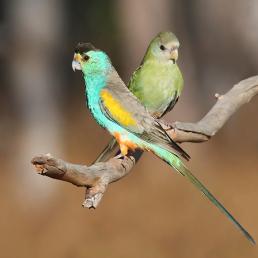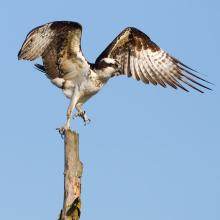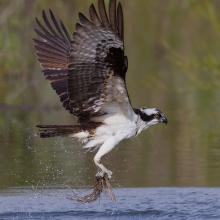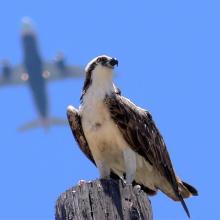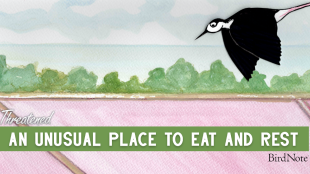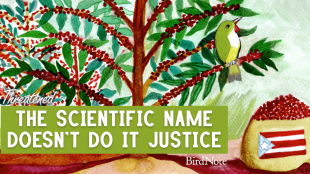

Join BirdNote tomorrow, November 30th!
Illustrator David Sibley and actor H. Jon Benjamin will face off in the bird illustration battle of the century during BirdNote's Year-end Celebration and Auction!
Birds in Montana are helping people figure out how to clean up a damaged environment.
Butte, Montana, used to be home to some of the most productive copper mines in the country. About a quarter of the world’s supply came from the area and it’s now the site of a massive effort to restore the degraded ecosystem. But, the local birds aren’t just victims of the pollution; they can actually tell us if things are getting better as all the pollution gets cleaned up. Birds here offer portraits of what’s happening on a larger ecosystem scale—especially Ospreys, which are at the top of the food chain and depend on waterways that are now contaminated with heavy metals. Producer Nick Mott travels along this polluted area to peer into the lives of these birds to see what they reveal.
Ari Daniel: BirdNote presents.
Erick Greene: So we come with a bucket truck when her babies are, you know, the size of a small cat. We do an alien abduction. We grab the chicks, bring them down to the ground and take a very small blood sample.
Ari Daniel: These bucket trucks are usually used to get workers up on top of a roof or a utility poll. But biologist Erick Greene has a very different target in sight. Every summer, he and his team get raised up to Osprey nests in search of chicks. They delicately band the birds, and take samples of blood and feathers.
These materials then get tested to look for traces of heavy metals. The results of those tests are clues to the progress of an attempt to clean up a century’s worth of mining pollution.
Erick Greene: The blood and feathers of those chicks is incredibly valuable because it integrates, you know, the whole food chain in the aquatic system, you know, right here at this spot.
[theme music]
Ari Daniel: Hey, I’m Ari Daniel, and this is Threatened.
Today, we head to northwest Montana. This area used to be home to some of the most productive copper mines in the country. About a quarter of the world’s supply came from the area, and it’s now the site of a massive effort to restore the ecosystem. What’s interesting is that the local birds aren’t just victims of the pollution. They can actually tell us if things are getting better as all that pollution gets cleaned up. Birds here offer portraits of what’s going on in the larger ecosystem. Reporter Nick Mott travelled along this polluted area in Montana to peer into those portraits, to see what they reveal.
Nick, what’s creating this toxic mess in the first place?
Nick Mott: Well, the simple answer is: copper. Copper mining dominated Montana’s economy for decades and decades. And it left a huge mess behind. The epicenter of that industry was in this city called Butte. Today, there’s just over 30,000 people there. But back when mining was in full-swing, it was the biggest city between Chicago and San Francisco. It drew workers in from all over the country - even all over the world. And it produced a seriously huge amount of copper. Locals take pride in the fact that copper helped electrify the nation through copper wire, and helped win wars through the materials that helped build ammunition.
Ari Daniel: But it sounds like that industry had a dark side?
Nick Mott: Oh yeah. Mining had all kinds of impacts, but the important thing to know is that the early days of getting that copper were all about underground mining. To give you a quick visual, miners dug 10,000 miles of mineshaft underneath just five square miles of earth. So imagine that sort of swiss-cheesing going on underground there. And back in the early 1900s, folks just kind of left the stuff they pulled out of the ground lying around once they’d gotten the copper out of it. And that stuff was full of some not-good metals, like arsenic and lead.
Butte also just so happens to sit right at the headwaters to the Clark Fork River. That flows into the Columbia, and eventually into the Pacific Ocean. So the pollution that starts in Butte can go a really, really long way. And mean that environmental damage spreads downstream.
Ari Daniel: And I’m guessing folks are trying to get it all cleaned up?
Nick Mott: Oh absolutely. There’s a huge cleanup effort underway. The biggest complex of Superfund sites in the country starts in Butte and goes more than 100 miles downstream along the Clark Fork River.
Ari Daniel: Superfund being shorthand for the federal program for cleaning up toxic messes.
Nick Mott: Exactly.
Ari Daniel: So how is the cleanup going?
Nick Mott: Well, the cleanups themselves are kind of messy — it’s all bureaucratic and really confusing, and some of the stuff way down the river got cleaned up before stuff in the middle or up near Butte, at the top of the river. Point is: they’re going on in a sort of patchwork, and they’re gonna take a lot longer. But also, a whole bunch of it has been cleaned up already.
Ari Daniel: Right — well, I’m really curious about those Ospreys, and I'm wondering how birds fit into this whole picture.
Nick Mott: Well, we’ll get to the Ospreys a little bit later. But to back way up — spoiler alert — pollution is obviously not good for birds. But as I started to report this, I’d heard that researchers were using birds to answer some questions that were super interesting to me about how the whole watershed is healing as it gets cleaned up. And I wanted to find out more about that. So I hopped in my car and followed the Clark Fork downstream from Butte.
[car door closing]
Nick Mott: My first stop is about a half hour by car from Butte. I’m meeting two guys who have been thinking about birds and the Superfund cleanup here for a long time.
Will McDowell: My name is Will McDowell and I work for the Clark Fork Coalition.
Nate Kohler: My name is Nate Kohler and my primary occupation is monitoring birds.
Nick Mott: Will and Nate arrived about 20 minutes before I did. Birders are always early, they tell me.
Will McDowell: How many species have you seen this morning, Nate?
Nate Kohler: Well, just sitting right there, I got, uh, 26.
Nick Mott: Twenty-six?
Will McDowell: Trumpeter Swans on that other pond.
Nate Kohler: Song Sparrow just sang too.
We’re along the upper stretch of the Clark Fork River, and both of them have been studying and advocating for the cleanup of the river for years.
Nick Mott: From where we stand, I can faintly see cars pass on the highway and the Pintler Mountains in the distance. Miles away, I also see a smokestack bigger than the Washington Monument from a smelter that used to process the ore from Butte. The land immediately around me is pretty much all private and agricultural.
Will and Nate wanted to meet here because:
Will McDowell: This area that we're standing in right now is the epicenter of contamination.
Nick Mott: And it’s also a focus of cleanup efforts. They’ve been studying how birds use this area for years.
We walk through willows and water birch, over uneven ground. And even though this is supposed to be ground zero for pollution, the vegetation is dense, and to me it looks healthy. Even lush.
Will McDowell: It's quite a diverse, sort of subtly diverse environment.
Nick Mott: And birds here seem to be doing pretty well.
Will McDowell: We're talking about, you know, warblers, vireos, grosbeaks, flycatchers, some of the sparrows that use these areas especially, in bird terminology, they call them neotropical migrants. They come from Mexico and Central America in the winter and they breed up here. Then they migrate south after this, you know, environment starts to cool off. But the abundance of insect life here in the summer months is what draws the species in.
Nate Kohler: At just two years of monitoring, the list stands at close to 90 species.
Nick Mott: Nate says those species of birds can reveal a lot about the huge effort to clean up millions of tons of mine waste. To get what he’s saying, you have to get a handle on what ‘contaminated’ actually means here. If you know where to look, you can find pollution all over the place, in the earth we’re walking on. We trudge over a bare spot in the soil.
Nate Kohler: This is actually a small patch of contaminated soils right there… Here's another one here.
Nick Mott: These are called slickens; they’re tailings, or the leftovers after the valuable stuff has been taken out of the ore mined beneath Butte. They were swept downstream and deposited in a monumental flood more than a century ago. They’re loaded up with heavy metals, and in certain times of the year, they turn bright, neon blue.
They’re the major problem for the ecosystem in this section of the cleanup. Storms can wash this toxic soil into the river— and that’s especially dangerous in late summer, when the water’s low. With less water to dilute the toxins, anything that goes into the river gets especially concentrated.
The slickens we’re seeing here are relatively small. But upstream Will and Nate say they can be a lot bigger.
Nate Kohler: Many of those locations were like the surface of the moon. Slickens as big as a football field, practically.
Nick Mott: Despite the slickens, this area has water and dense vegetation; so many birds depend on the ecosystem here.
Will McDowell: The majority of species of birds in Montana actually use riparian areas like this at some point. You know, Nate was just saying he saw 26 species of birds here in 20 minutes this morning. Right. That's because of the diversity between ponds and sloughs and river and floodplain and adjacent prairie and grasslands. You have all these different environments. But the key is this riparian band of vegetation, which is like an oasis in a desert environment.
Nick Mott: Nate, you just pointed out something and pulled out your phone, what did you see?
Nate Kohler: Kestrel just flew by. Number 27 while we've been here.
Nick Mott: Will, Nate, and I cross the road. They want to show me a different part of the riverbank that’s not so toxic— it’s already undergone a major cleanup.
Will McDowell: This is part of a giant experiment.
Nick Mott: There are two steps in the cleanup process here. The first one is remediation. That’s just getting all the metals and bad stuff in the ground out of there. Cleaning it up. The other term is restoration. That’s what comes next — it means creating a healthy and functioning ecosystem once the pollution’s been scooped out of the ground.
So this site we’re walking to has already been remediated. The nasty stuff in the ground got dug up.
Will McDowell: This site here had 500,000 cubic yards of contaminated sediment removed. That's 50,000 large dump truck loads. That's a lot of dirt.
Nick Mott: And Will is referring to just a small section of land that’s been fixed up. But getting the contamination out of the ground everywhere is an effort that will take decades and hundreds of millions of dollars. The difficulty isn’t just the labor and the cost - it requires some serious buy-in from locals, too.
Will McDowell: Now, that's a pretty harsh concept, really, when you look at it. These people have been sometimes generations on this land. They've been using it. They're aware that it's contaminated, but they've been using it successfully to raise cattle. What was being proposed to them is we want to tear your whole floodplain to pieces. We want to turn your land upside down, rip all the plants out of the floodplain, take all the top layers of soil off that are contaminated, replace that with new soil and replant. So basically completely tear your land apart, put it back together. And don't worry, it'll be fine. Right. Well, don't worry, the government will handle it. It's going to be fine. That doesn't fly very far with rural landowners.
Nick Mott: Just like the people that’ve made a living on this land for generations, birds, too, have been using the land despite the contamination. And the cleanup has moved onto step two here: restoration.
On this particular parcel, the riverbank and floodplain were basically rebuilt. New stuff was planted. And looking around, I’m pretty surprised by what I see. Since we’re in an area that’s been cleaned up, I expect green, vibrant, lush vegetation. But instead, we trudge into a landscape that’s much more barren than the contaminated area we were in before. The few willows that are standing are scrawny, and mostly right up against the streambank. Even though the toxic stuff is gone, there aren’t nearly as many plants as that contaminated area we saw.
Nick Mott: As an onlooker coming in, I might think that this was the place that was contaminated, because it has so much less vegetation than across the road.
Will McDowell: Yeah, yeah. And it's kind of the reverse. Right. Right. And that's you know, that's the irony of the whole thing,
Nick Mott: So part of the reason this area is sort of barren is a really tiny detail of design: the floodplain was built back just a few inches too high. It means that restoration work is likely pretty safe from flooding. But it also means fewer trees and shrubs are naturally recolonizing.
Restoring a river ecosystem is a balancing act. You can try to mimic how things used to be, and allow the river to change where it flows and to flood. Or you can build up the banks and try to make sure the river stays its course. Things are more predictable that way - less risky.
Will McDowell: We're trying to lobby for taking a little bit more risk to get really high quality habitat restoration. And that's something where engineers are talking to ecologists are talking to geomorphologists. And there's all these ologists that are trying to decide exactly where is that floodplain level going to be established. And we're talking negotiations about inches. Two inches higher? No, no, no. Three inches lower. No, no, no. And that has everything to do with whether it's going to naturally revegetate.
Nick Mott: Those minute differences can make a world of difference to birds that rely on the habitat that forms right on the edge of the river. So birds have something really important to say about this critical step in the cleanup process — monitoring how they use the area after it’s been restored helps access a bigger picture perspective on the ecosystem that can be hard to see on the ground. Will and Nate are asking:
Will McDowell: Did the bird community come back to what was there before? And therefore, did you get full ecological restoration where you're getting the species that are supposed to be there re-inhabiting that habitat?
Nick Mott: Nate’s job is to monitor all the birds showing up in contaminated areas. In summertime, he arrives before sunrise every morning to monitor dozens of sites. He tracks what the birds are doing as remediation occurs, and then as restoration progresses: are the same birds flying in? Or maybe more, or fewer? And then, when things have been restored and the plants are growing back: how are birds doing then?
Nate Kohler: If you keep repeatedly visiting these locations, either before or after remediation, you get a picture of the changes that have occurred. It's a good way, it's a good measuring tool, watching the birds.
Nick Mott: Nate has a really close relationship with this area; when he’s out counting birds, he spends hours alone, watching and listening to the land, every day.
Nate Kohler: If you build it and if you build it right, the birds will come. And if you compare it to what it was previously, it's like night and day.
Nick Mott: Today, about 20 percent of the Upper Clark Fork has been cleaned up. Will guesses the rest of the cleanup here could last nearly another two decades.
Will McDowell: There's another species. Ring-billed gull.
Nate Kohler: I've already got it on the list, Will.
Will McDowell: That's the way it works. When I'm out in the field with this guy, I think I'm showing him something and he's already seen it.
Nick Mott: So that's that. Twenty-seven.
Nate Kohler: We're up to 31.
Nick Mott: Up to 31! You've been just documenting this whole time while I've been asking questions.
Will McDowell: Yeah, Turkey Vultures, Yellow-headed Blackbirds, few other things.
Nate Kohler: And there's a 32nd, that's a female Hooded Merganser that just screamed upstream there.
[music]
Ari Daniel: This upper part of the river is just one small part of this massive cleanup that extends way downstream. When we come back, Nick heads down river to meet some raptors that have a lot to say about how the river-wide cleanup is going, big picture.
MIDROLL
Nick Mott: When I meet bird biologist Erick Greene, he’s wearing an “Ospreys” baseball hat and an Osprey shirt.
Erick Greene: I'm an Osprey freak, I admit it.
Nick Mott: Lucky for me, the highway mostly follows the Clark Fork downstream, to the end of the Superfund cleanup. I meet Erick in Missoula, about an hour and a half away from Will and Nate. He takes me up to his office on the University of Montana campus, where there are photos of Ospreys everywhere and a life-sized paper model of the raptor hanging from the ceiling.
And then he pulls out:
Erick Greene: Well here’s a really cool articulated skeleton of an Osprey.
Nick Mott: He points out the skeleton’s bulging breastbone.
Erick Greene: I mean, this is like the Arnold Schwarzenegger of the bird world. So, you know, one muscle, their pecs weigh like a third of their body mass. It's insane.
Nick Mott: That’s because they need to be able to take off from the surface of the water, carrying a trout that weighs nearly as much as they do.
Ospreys are tied to water. So here, at the edge of the country’s biggest group of toxic waste cleanups, Erick’s research on Osprey offers a window into the state of pollution in this whole watershed.
Erick Greene: I like to say just add water and you get Ospreys, because they're found everywhere, all over the world. There's one species of Osprey. That's it. And they're found on every continent except Antarctica. And all they eat is fish. They're super specialists.
Nick Mott: He wants to introduce me to one Osprey in particular. Her name’s Iris, and at 24 years old, she’s believed to be the oldest Osprey in the world. And she’s famous all over the globe. Because there’s a live-stream of her nest, right here in Missoula.
Erick Greene: This is a super high-res camera. This is sort of the Cadillac of the camera world.
Nick Mott: Unfortunately, Iris is out fishing when we check the feed. But he zooms around to show me the technology. Later, I go online to take a look at Iris in action. And I’m not the only one watching.
Erick Greene: It's gone viral, right, and it's watched by a gazillion people around the world. And so that's really interesting because we're able to, our reach on letting people learn about the problems in the Clark Fork River and the heavy metal pollution and all that, it’s not just local.
Nick Mott: He says Iris has her own personal soap opera playing out in the public eye. To find out what he means, I follow him across town, to an Osprey nest by a local baseball stadium.
[car door closing]
Nick Mott: Alright, so the nest is - right over there, I see it!
Nick Mott: A female Osprey is incubating her eggs while her companion, a male named “Louis,” stands guard.
Erick Greene: So there you can see the tail and see how her tail’s bobbing around a bit. We could just see her tail, her rear end. But I know from having spent so much time watching them, she's turning the eggs right now.
Nick Mott: But Louis is Iris’ mate too… and like in a lot of reality shows, the subject of much online controversy. Louis often flies over to mate with Iris, then leaves her to come back to this nest, to his other lady raptor. So for poor Iris, he loves her and leaves her. To online watchers, Louis, basically, is a bit of a jerk.
Erick says there are probably about 30 Osprey nests within 15 miles of this spot. And he says Louis and his mate recognize him.
Erick Greene: You can hear them talking to each other. It's interesting. She knows us.
Nick Mott: That’s because Erick and the other scientists in the project get up close and personal with these birds in order to look for signs of how much of that heavy metal pollution has made its way from its original source in Butte, through those slickens we saw upstream, all the way here, more than 100 miles away.
Erick Greene: And so that blood and the feather we take are really important so we can analyze those blood and feathers for, for example, the big five heavy metals, which are arsenic, cadmium, copper, zinc and lead.
Nick Mott: Adult Ospreys spend about nine months of the year down in South and Central America. That means any toxic metals found in the adults could have come from somewhere else entirely. But the babies are hatched here along the Clark Fork. So everything they’re eating comes right out of the river. They’re perfect test subjects for what metals are still making their way downstream.
Erick Greene: That chick, all of that biomass, all that chick grew from fish that were caught within a mile or so of this nest.
Nick Mott: They’re predators high up in the food chain, so the metals become particularly concentrated in the blood of the birds. Erick says this is an example of a process called bioamplification.
Erick Greene: And what it means is that as you move up, move up a food chain, these contaminants get concentrated to higher and higher levels. And just very roughly, it's about 10 times the amount of contaminants at a level in a food chain than the one below it. So by the time you get up to Ospreys that are eating many, many, many big fish, and those big fish have eaten lots of medium sized fish, who have eaten lots of smaller fish, the levels of, say, mercury in these Ospreys can be 10,000 times higher than at the lowest levels in an aquatic food chain.
Nick Mott: To mix metaphorical birds, they’re the canary in the coal mine, letting the rest of us know when the pollution is shooting dangerously high.
Erick says so far, monitoring the Ospreys has brought, well, good news and bad news.
Erick Greene: Well, the good news is that the restoration, you know, the clean up for most of the big five heavy metals seems to be working really well.
Nick Mott: The key word here is most. When it comes to arsenic, the data tell a different story.
Erick Greene: Arsenic was doing really well. In 2018, arsenic levels from about Deer Lodge down shot through the roof.
Nick Mott: Deer Lodge is the name of the valley upstream where I saw those slickens… which are likely causing the spike in arsenic levels. In late summer of 2018, when the river was low, thunderstorms hit the area. The storm-water rushed through the slickens, pushing the metals into the river. There was a big trout die-off near the area I explored with Will and Nate. That contamination flowed downstream, where it got bioamplified in the baby Ospreys.
And the tests also revealed another metal that wasn’t even supposed to be part of the cleanup.
Erick Greene: The other problem that we stumbled on that was not suspected was super high levels of mercury. And mercury is a very, very toxic element. It's a neurotoxin. It disrupts development in embryos, so it's bad news. To give you an idea, the upper limit in human blood is set [at] about five parts per billion. And these chicks right here have routinely 250, 300, 350 parts per billion. If you or I walked into St. Pat's right across the river here with those levels of mercury, it would be considered like code blue. I mean, the doctors would be freaking out and starting chelation therapy and the whole works.
Nick Mott: He traced the source of that mercury not to the old copper mines in Butte - mercury isn’t one of the big five metals he mentioned - but to gold and silver mines elsewhere on the river. They’re equally a part of our industrial past - but just not the part of that past anyone had been expecting. So those baby Ospreys taught us that pollution might lie in places we weren’t even looking before. And they paid a price to teach us that lesson:
Erick Greene: From 2018 on, there has been massive reproductive failure among the Osprey chicks, basically from Deer Lodge down to here, been very few Osprey chicks that have survived. And it may be because of very high arsenic levels or there's also been, the fish populations, trout populations in particular, have tanked in certain areas of the river.
Nick Mott: Erick still has one more place to show me in Missoula that has lots to say about the toxic legacy of mining here on the Clark Fork.
[car door closing]
We arrive at the westernmost edge of the cleanup — more than a hundred miles downstream from where we started: Milltown State Park.
Erick Greene: This was sort of ground zero, so to speak.
There used to be a dam here; it split the Clark Fork in two. But about a decade ago, they tore it down. Arsenic was getting into the local groundwater, likely because the same flood that formed those slickens along the Upper Clark Fork pushed even more tailings way down the river. When they hit the dam, they piled up behind it and sat there for decades.
Erick Greene: If you look across the river, you can see those stumps, old stumps there. Yeah, those are 100 year old stumps that were buried under about 30 or 40 feet of toxic sludge.
Nick Mott: Now, along with the dam, all that sludge is gone and the river runs free. This state park is a symbol of renewal, and what the cleanup could mean for the watershed.
Today, caddisflies are swarming. They’re sensitive to pollution, and also prime grub for the trout under the water.
Erick Greene: So, a sign of really good, clean water.
Nick Mott: No Ospreys are in sight, but swifts and swallows are swooping around, plucking the caddisflies out of the air.
Erick Greene: And these are the, this is the food for the fish. Right. Which would be the food for the bigger fish, which would be the food for the Ospreys.
Nick Mott: For Erick, Ospreys really are the star of the avian show. Spending so much time thinking about, watching, and interacting with the birds, the things he learns go well beyond pollution.
Erick Greene: My admiration for Ospreys just continues to grow. You know, when I watch, for example, Iris, who's got her own personal soap opera struggles going on, but she keeps on going. I just, I admire them as a wildlife species that has got lots of challenges and threats still going on. And yet they're figuring out ways to, you know, live in the present environment and live successfully with people. And that's a really uplifting message. We all need uplifting messages these days.
Nick Mott: Erick says the image here — a river flowing free, wildlife all around — seems pretty rosy. But if you look closely at what Ospreys are telling us, the reality isn’t all clear water and hatching caddisflies and happy birds.
A lot of cleanup still needs to happen along the river. That will take years — and there’s no telling how long the high arsenic and mercury levels will persist in Ospreys. But when Erick talks about these challenges ahead, he can’t help but get distracted by the very clear evidence of success all around us.
Erick Greene: We're hoping that this is just a short term thing. [pause] I'm hearing, White-throated Swifts flying over right now, gobbling up these macroinvertebrates. Very special. Very few places in the state where you can stand and hear White-throated Swifts. So this is a special spot.
Nick Mott: There’s sort of a dissonance here. There’s recovery and continued contamination all at once, all bound up. It’s hard to separate out one from the other. And maybe that’s what living with the legacy of resource extraction requires: finding the bright spots and beauty where we can and, like Ospreys, persisting.
[theme music]
Ari Daniel: Here in Montana, the birds tell us about the pollution we’ve created, and how it’s improving. Over in the UK, people are rallying behind a different bird — the puffin.
David Craven:I think it’s the charisma that they bring. They are — I mean, I hate using the word cute — but I think that is exactly what it is.
Ari Daniel: But can the cuteness and charisma of a single bird inspire us to clean up our environment? That’s next week on Threatened.
This episode was produced by Nick Mott and me, Ari Daniel, and edited by Caitlin Pierce of the Rough Cut Collective. Audio mix by Rob Byers, Johnny Vince Evans, and Michael Raphael of Final Final V2. Our theme song and original music were composed by Ian Coss, with additional music by Blue Dot Sessions. Threatened is a production of BirdNote and overseen by Content Director Allison Wilson with production assistance from Sam Johnson. You can find our show notes with additional resources, BirdNote’s other podcasts, and much more at BirdNote dot org. Thanks for listening. See you next time.
